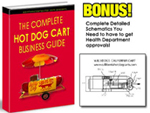Calculating the costs of starting a hot dog cart business
Calculating the costs of starting a hot dog cart business
Once you have an estimate of startup costs, you can seek operating capital, if needed. Operating capital might be received in the form of cash, credit cards, or loans, among other options.
The components listed below reflect the essential pieces of equipment required to get started. As your company evolves, we’ve also included a separate list of products that will be required for future growth and development.
Expenditure breakdown for getting started.
Equipment:
The following are the specs for a hot dog cart:
- Dimensions: 40 inches wide by 48 inches long by 24 inches high.
- The dimensions of the trailer are 52 inches wide by 78 inches long by 56 inches high.
- Brake and signal lights, as well as a trailer wire harness, have been added electrically.
- Hot dog cart weight: roughly 350 lbs (160 kg) when empty.
- Cam locks are made of brass that is vibration-proof for further security.
- Sinks-3 sinks are standard, with the option of adding more.
- Tank for freshwater (five gallons)
- Tank for wastewater (seven gallons)
- Cooler storage-insulated top entrance icebox for up to 98 drinks and a pound of ground beef
- Top-side display space, as well as additional under-counter dry storage space
- Propane tank with two 20-pound tank baskets
- Gas regulator with two stages of operation burners with customizable controls: two 17, 000 BTU burners
- A wind umbrella measuring 6 1/2 feet in height.
- Pans for steaming-5 steaming pan a third of the size x six
- Additional standard features include cart push handles, hot and cold running water, and a trash compactor.
- Bun warmers are used to keep buns warm.
- Dispensers and containers for condiments
- Napkin dispensers and napkins
- Large tongs
The cost of obtaining insurance will vary from carrier to carrier. You will require general liability insurance (for up to $1,000,000). Check with your insurance agent for specifics and keep track of what your coverage includes.
Marketing costs.
Marketing costs can vary wildly. Keep in mind that your product and reputation with clients is the best and cheapest marketing you can do. Building a reputation and goodwill over time will offset the costs of marketing over time. This goodwill and reputation are what will give your operation real value if you decide to sell it in the future. So whatever marketing you choose to do should be supported by treating clients with respect kindness even where they’re being unreasonable or you’re having a hard day.
At the beginning, set aside some money for doing some advertising in the area, you will be operating in. I suggest challenging yourself to creatively set a budgeted amount with very specific sales goals in mind. Youtube videos marketing to the strict area where you will potentially have foot traffic, targetting using tight geofencing will be a great way to get hungry diners to you cart with minimal costs. Read up on these two concepts and master them.
Many small enterprises turn to local Small Business Administration (SBA) lending programs when looking for start-up financing. Lenders are unlikely to approve your application for a business loan if you do not have a business plan. There are many different loan programs available to small businesses, so you must do your homework to determine which loan program is the best fit for your company.
Statement of Loan Disbursement
You can distribute your loan or credit card funds as you see fit in accordance with your start-up budget based on the amount of cash you have on hand. It is critical to avoid growing too quickly and outstripping your financial resources. Because the loan application procedure can be time-consuming, you should seriously consider using credit cards to support your business if you do not have enough cash on hand.
When you begin to generate positive cash flow, allocate 50 percent of the funds to grow and 50 percent to debt repayment, starting with the first dollar. Your firm may never recover if you overextend yourself by taking on too much debt.
Credit Terms and Conditions
You may elect to give credit to consumers who are frequent and dependable in their purchases. However, you will want to collect the majority of payments at the time of delivery in order to minimize the burden of chasing down payments that your clients owe you in the future. If you do decide to extend credit to customers, you should send them an invoice and give them 30 days to pay the balance in full.
Bank Account for a Company
Some business owners choose to open a separate business account with a bank in order to keep their personal and business costs separate from their personal finances. This helps you to conveniently track income and expenses, which in turn allows you to evaluate the overall performance of your business. To open a bank account in your company’s name, you will need to provide the following documentation:
Your business name must be distinct from your personal identity, and you must register the fictitious business name if your business name is distinct from your personal identity.
You can file for your business name with your county’s Recorder Department for $20 to $80 per fictitious business name, depending on your location. You must make your DBA known to the general public in order to finish the registration process. This informs the general public that you are conducting business under your DBA and not under your own name as a sole proprietor. A list of local newspapers that will let you purchase an ad for a period of many weeks will be available from your County Recorder Department, allowing you to make your DBA known to the general public.
Identifying information such as social security number
Partnership Agreement (only for partnerships): A copy of your partnership agreement will be required by the bank.
Make certain that all of the partners have signed the partnership agreement.
Operating Agreement for a Limited Liability Company (LC only ) A copy of your LLC operating agreement will be required by the bank.
Articles of Incorporation (available exclusively for S-corporations and C-corporations): A copy of your articles of incorporation will be required by the bank.
Performing a break-even analysis
The break-even point is the moment at which a company’s expenses exactly match the amount of money it earns from sales or services. It can be expressed in either of the two ways listed below.
Completely offset by all of the expenses or total units of production (whose cost exactly equals the income obtained from their sales).
Because you are in the product industry, you will use the second calculation to estimate your breakeven point in order to maximize profits.
This analysis can be carried out in either a mathematical or a graphical format. The revenue and expense figures are derived from the income estimates (for income projections, see the “Three Year Income Statement Projection” section of this document).
Consider these questions:
What is your projected time frame for achieving break-even?
If you intend to run this business full-time, how long do you think you will be able to survive without a consistent source of income?
Thinking about taxes
It is determined by the type of business you own and operate as to what taxes you must pay and how you must pay them. The following is a list of numerous business taxes that may be applicable to your organization.
Tax on Earnings
Every firm is required to file an annual income tax return with the IRS or the CRA if you live in Canada. The type of form you employ is determined by the legal structure of your company. Withholding taxes are not applied to the profits from your firm. Most of the time, you pay your taxes throughout the year when you earn income. S-corporation owners who are sole proprietors, partners, or shareholders pay their taxes as they go by making regular tax payments based on the expected yearly tax for the year in question. The Internal Revenue Service (IRS) requires you to disclose the income earned by your independent contractors if they earn more than $600 in a calendar year. It is the independent contractor’s responsibility to ensure that the necessary income taxes are paid.
Obtaining free forms and instructions for various sorts of business filings can be accomplished by visiting the Internal Revenue Service’s website (www.irs.gov)
The Tao of Self-Employment
Individuals who work for themselves, whether as single proprietors or as partners in a partnership, are subject to the self-employment tax, which is a form of Social Security tax. Calculation and reporting of self-employment tax are done on Schedule SE, which is attached to and filed with Form 1040, which is for employment-related expenses.
With employees, you will very certainly be obliged to pay federal income tax withholding, Social Security and Medicare taxes, federal unemployment tax (Form 940 or Form 940EZ), and state income tax withholding, among other things.
Excise Tax is a tax levied on goods and services.
If you manufacture or sell certain products, you may be subject to excise tax. Make careful to verify with the federal, state, and local governments to determine whether any excise taxes, permits, or licenses are required for your particular company venture.
Taxation Services Provided by Third Parties
One example of outsourced tax functions is the submission of your tax return to a professional Certified Public Accountant (CPA) for completion and submission. At the conclusion of each year, unless you are a certified public accountant, we recommend that you take your yearly income statement and a list of all acceptable business deductions to your CPA or tax preparer. This will ensure that all income is properly recorded and reported.
Estimation of Three-Year Profit and Loss Statement
The income statement summarises the financial activity of your company (revenues and expenses) over a period of time, which is typically monthly and/or annually. It is a moving image that depicts what has occurred in your company, and it is a wonderful tool for determining the health of your organization. Once your ledger is closed, the net income or loss is transferred to the balance sheet and recorded in the owner’s equity portion of the statement. Be aware that, once all of the necessary information has been recorded, the majority of accounting software systems can calculate the common financial statements for you. The income statement estimates provided on the following three pages will be similar in appearance to the income statement forecasts you will prepare while creating your business plan.
Cash Flow Predictions for the Next Three Years
The cash flow statement forecasts how much money your business plan will generate in a certain period of time. Generally, it is used for internal planning since it illustrates the inflows and outflows of funds over a period of time (typically monthly and/or annually). If you are taking out a loan to fund your firm, it is in the lender’s best interests to see a business plan that outlines how you intend to return the loan. Cash flow statements illustrate both how much and when cash must flow into and out of your firm. They also show how much cash must flow into and out of your business.
The cash flow statement estimates provided on the following three pages will be similar in appearance to the cash flow statement forecasts you will prepare while creating your business plan.
Documents in Support of the Proposal
Your business plan’s records part will contain all of the documents that provide evidence to support the statements and decisions made in the main sections of your business plan. The most often encountered supporting documents are as follows:
Personal Resume
Include the resumes of the business’s owners and management. It is recommended that your resume be a one-page document that includes the following information.
An overview of one’s professional experience
Qualifications in the field of education
Awards and ties with professional organizations
Particular abilities relevant to the company’s position
Financial Statements of the Owners
Include personal financial statements for each of the business’s proprietors. The financial statement will include information about assets and liabilities held outside of the business, as well as information about personal net worth.
Owners will frequently be forced to use personal assets to finance their businesses, and these financial documents will show them what they have available. Bankers and investors are frequently interested in this information as well.
You will require credit reports for each of the company’s shareholders. The three major credit reporting organizations can provide credit reports to you. Choose whichever one you choose (Experian, Transunion, and Equifax).
Once every 12 months, you can log on to www. annual credit report.com to access your credit reports from each of the three credit reporting organizations listed above. This service is provided free of charge in accordance with federal legislation.
Copies of leases, mortgages, and other agreements, as well as other documents
It is necessary to include all agreements currently in effect between your organization and a leasing agent, mortgage company, or other agency.
Letters of Recommendation
letter(s) of recommendation outlining your reputation as a trustworthy and reliable businessperson who is deserving of being regarded as a good risk (both business and personal references). A loan application is made all the more difficult by the need for reference letters.
WHY CHOOSE US
HAPPY CLIENTS
Lorem ipsum dolor sit amet, consectetur elitad adipiscing Cras non placerat mipsum dolor sit amet, consectetur elitad adipiscing cas non placerat mi.
Lorem ipsum dolor sit amet, consectetur elitad adipiscing Cras non placerat mipsum dolor sit amet, consectetur elitad adipiscing cas non placerat mi.




